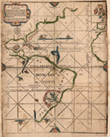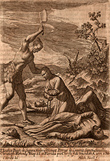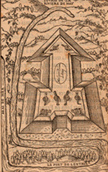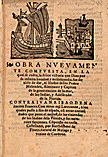France and Spain on the North American Coast At the beginning of the sixteenth century explorations under John and Sebastian Cabot disclosed a substantial part of the northernmost coasts of North America, but the time was not yet right for English colonizing ventures and these voyages were not followed up. The next several decades saw the extended coastline of eastern North America from Newfoundland to Florida revealed by French and Spanish reconnaissance voyages, but as none of the ventures found rich natural products to exploit, those early explorations did not lead to attempts at settlement either. Spain did make a few tentative gestures in Florida between 1521 and 1561, but a permanent presence was not established until their interests were challenged by French Protestants who staked out colonies in what is now South Carolina at Port Royal in 1562 and Charlesfort in 1565. Pedro Menéndez Avilés was sent to put a stop to these incursions and his successful destruction of the French colonies and the foundation of a Spanish outpost at St. Augustine left Spain in control of the southeast coast of North America. |
||
[1] The Spanish View of North America The Ramusio map of 1534 was derived from the official Spanish cartographic record of New World discoveries, the padron real. On this map, "licentiato ailon" refers to Lucas Vazquez de Ayllón (ca. 1475-1526) who received a license from the Spanish crown to explore the coast of Spanish "Florida" in 1520. After an initial reconnaissance voyage, he returned to plant a colony in 1526 and his settlement, San Miguel, was located where the English would later establish Jamestown. Vazquez de Ayllón died of a fever four months after his arrival and his quarreling colonists soon abandoned the settlement. "Stevã Gomez" recognizes the 1525 reconnaissance voyage by Estevan Gomez along the New England coast. These references are reminders of active Spanish interest in the American coast well to the north of present-day Florida. |
||
[2] Attempted Spanish Settlement on the Chesapeake In 1561 Paquiquineo, a high-born Paspahegh youth from Chesapeake Bay, joined a party of Spanish explorers. Treated as an aristocrat, he eventually wound up in Spain, converted to Catholicism, and was baptized Don Luis after his sponsor, Viceroy Don Luis de Velasco. In 1570, he returned to North America in the company of Father Joannes Baptista de Segura and his companions, who were on a mission to the Indians in the Chesapeake Bay area called by the Spaniards the Bahia de Santa Maria de Ajacán. After the missionary party landed, Don Luis renounced the Christian faith and returned to his people. The Fathers protested and Don Luis, apparently angered by their harangues, murdered the missionary party. The Paquiquineo/Don Luis story suggests the complicated issues of cultural convergence and conflict that were an integral part of the encounters between Americans and Europeans in this early period. |
||
[3] France and Spain Face Off in the Southwest Sixteenth -century French attempts to establish a presence on the southeast coast of North America tell a sad story from beginning to end. In 1562 Jean Ribaut led a group of Huguenots to Parris Island, South Carolina, and erected Fort Caroline. The venture was short-lived. Ribaut returned to France for reinforcements and his colonists, unable to support themselves, followed a few months later. Two years later, René de Laudonnière made another colonization attempt further south near present-day Jacksonville, Florida. That colony was destroyed by Pedro Menéndez de Avilés, who had been entrusted by Spain with the task of driving the French from the region and establishing a colony in Florida to defend Spanish claims. |
||
[5] Spanish Celebration in Verse This account in verse of the destruction of the French colony is the only contemporary printed record of the Spanish/French conflicts from the Spanish point of view. Midcourse it becomes a promotion tract for a Spanish colony that Pedro Menéndez de Avilés was trying to establish in Florida as a buffer against French and English incursions. |
||
| Exhibition prepared by Susan Danforth, Curator of Maps and Prints, John Carter Brown Library. On view in the Reading Room August to November 2007. |

 |
||||||
|---|---|---|---|---|---|---|
| France and Spain on the North American Coast
|
Stirring up English Interest
|
The Beginning of the Virginia Venture
|
A Second Chance for Jamestown
|
Settlement Encouraged
|
Virginia Commodities
|
|



